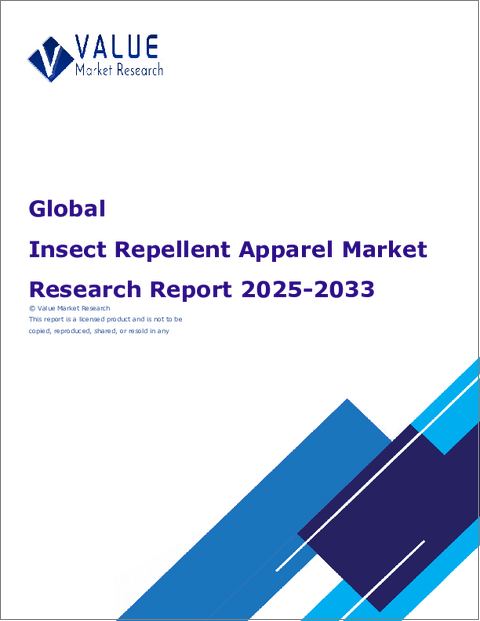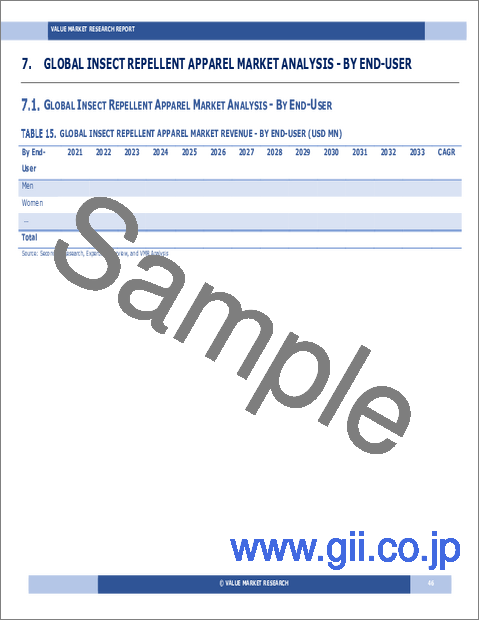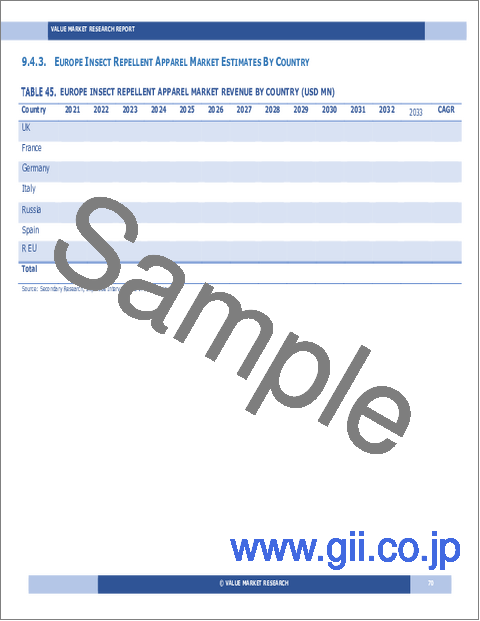|
|
市場調査レポート
商品コード
1762017
虫除けアパレルの世界市場調査レポート:産業分析、規模、シェア、成長、動向、2025年から2033年までの予測Global Insect Repellent Apparel Market Research Report- Industry Analysis, Size, Share, Growth, Trends and Forecast 2025 to 2033 |
||||||
カスタマイズ可能
|
|||||||
| 虫除けアパレルの世界市場調査レポート:産業分析、規模、シェア、成長、動向、2025年から2033年までの予測 |
|
出版日: 2025年07月01日
発行: Value Market Research
ページ情報: 英文 159 Pages
納期: 即日から翌営業日
|
- 全表示
- 概要
- 図表
- 目次
虫除けアパレルの世界市場規模は、2024年の6億7,987万米ドルから2033年には12億1,053万米ドルに成長し、2026年から2033年の予測期間中に6.62%の堅調な年間平均成長率(CAGR)を示すと予測されます。
虫除けアパレル市場は、昆虫が媒介する病気に対する消費者の意識が高まるにつれ、大きく拡大する見通しです。ライム病やジカウイルスなどの病気の流行が増加する中、個人は虫刺されから身を守るための効果的な解決策を求めています。虫除け技術を応用した衣料品は、アウトドア・アクティビティを楽しみながら身の安全を高める実用的で便利な方法を提供します。メーカーが生地の加工や技術の革新を続けていることから、この市場は、アウトドア愛好家から、衣服に保護機能を求める日常的なユーザーまで、多様な消費者を惹きつけると予想されます。
さらに、アウトドア・レクリエーションやアドベンチャー・ツーリズムの動向の高まりが、虫除けウェアの需要を牽引しています。ハイキングやキャンプ、南国への旅行といったアクティビティに参加する人が増えるにつれ、防護服の必要性が最も高まっています。虫除けウェアの機能性と快適性を強調し、その利点を効果的に売り込むブランドは、売上とブランド・ロイヤルティを増加させると思われます。さらに、環境意識の高い消費者の増加により、メーカーは持続可能な素材や生産方法を模索するようになり、環境意識の高い買い物客の価値観と一致しています。このような持続可能性への注目は、ブランドの評判を高めるだけでなく、虫除けアパレル市場全体の成長にも貢献すると思われます。
虫除けアパレル市場の将来は、技術の進歩や消費者の嗜好によっても左右されます。より持続的な防虫効果と快適性の向上を実現する生地加工のイノベーションは、市場成長の重要な原動力となるでしょう。消費者は、スタイル、快適性、保護機能を兼ね備えた多機能衣料をますます求めるようになっており、これらの要素をうまくデザインに組み込んだブランドは、競合情勢の中で際立つ存在となると思われます。虫除けアパレル市場は、健康への関心の高まり、アウトドア活動の動向、持続可能な慣行へのコミットメントを原動力として、成長する好位置にあります。
当社のレポートは、様々な産業や市場に関する包括的かつ実用的な洞察をお客様に提供するために綿密に作成されています。各レポートは、市場情勢を完全に理解するために、いくつかの重要な要素を含んでいます:
市場概要:定義、分類、業界の現状など、市場に関する詳細なイントロダクション。
市場力学:市場成長に影響を与える主な促進要因・抑制要因・機会・課題を詳細に分析します。このセクションでは、技術の進歩、規制の変更、新たな動向などの要因を検証します。
セグメンテーション分析:製品タイプ、用途、エンドユーザー、地域などの基準に基づき、市場を明確なセグメントに内訳。この分析により、各セグメントの業績と将来性を明らかにします。
競合情勢:市場シェア、製品ポートフォリオ、戦略的イニシアティブ、財務実績など、主要市場企業の包括的評価。主要企業が採用する競合力学と主要戦略に関する考察を提供します。
市場予測:過去のデータと現在の市場状況に基づき、一定期間における市場規模と成長動向を予測します。これには、定量的分析と将来の市場軌跡を示すグラフ表示が含まれます。
地域分析:地域ごとの市場パフォーマンスを評価し、主要市場や地域動向を明らかにします。地域の市場力学とビジネスチャンスを理解するのに役立ちます。
新たな動向と機会:現在の市場動向と新たな市場動向、技術革新、潜在的な投資対象分野を特定します。将来の市場開拓と成長見通しに関する洞察を提供します。
目次
第1章 序文
第2章 エグゼクティブサマリー
- 市場のハイライト
- 世界市場スナップショット
第3章 虫除けアパレル産業分析
- イントロダクション:市場力学
- 市場促進要因
- 市場抑制要因
- 市場機会
- 業界動向
- ポーターのファイブフォース分析
- 市場の魅力分析
第4章 バリューチェーン分析
- バリューチェーン分析
- 原材料分析
- 原材料リスト
- 原材料メーカーリスト
- 主要原材料の価格動向
- 潜在的バイヤーリスト
- マーケティングチャネル
- ダイレクトマーケティング
- インダイレクトマーケティング
- マーケティングチャネル発展動向
第5章 虫除けアパレルの世界市場分析:タイプ別
- タイプ別概要
- タイプ別過去および予測データ分析
- ヘッドカバー
- ジャケット
- シャツ
- ズボン
- その他(靴下など)
第6章 虫除けアパレルの世界市場分析:価格帯別
- 価格帯別概要
- 価格帯別過去・予測データ分析
- 低価格帯
- 中価格帯
- 高価格帯
第7章 虫除けアパレルの世界市場分析:エンドユーザー別
- エンドユーザー別概要
- エンドユーザー別過去・予測データ分析
- 男性
- 女性
- 子供
- ペット
第8章 虫除けアパレルの世界市場分析:流通チャネル別
- 流通チャネル別概要
- 流通チャネル別過去・予測データ分析
- オンライン
- オフライン
第9章 虫除けアパレルの世界市場分析:地域別
- 地域別展望
- イントロダクション
- 北米売上分析
- 概要、実績と予測
- 北米:セグメント別
- 北米国別
- 米国
- カナダ
- メキシコ
- 欧州売上分析
- 概要、実績と予測
- 欧州セグメント別
- 欧州国別
- 英国
- フランス
- ドイツ
- イタリア
- ロシア
- その他の欧州
- アジア太平洋売上分析
- 概要、実績と予測
- アジア太平洋セグメント別
- アジア太平洋国別
- 中国
- インド
- 日本
- 韓国
- オーストラリア
- 東南アジア
- その他アジア太平洋
- ラテンアメリカ売上分析
- 概要、実績と予測
- ラテンアメリカ:セグメント別
- ラテンアメリカ国別
- ブラジル
- アルゼンチン
- ペルー
- チリ
- その他のラテンアメリカ
- 中東・アフリカ売上分析
- 概要、実績と予測
- 中東・アフリカセグメント別
- 中東・アフリカ国別一覧
- サウジアラビア
- アラブ首長国連邦
- イスラエル
- 南アフリカ
- その他の中東・アフリカ
第10章 虫除けアパレル企業の競合情勢
- 虫除けアパレル市場の競合
- 提携・協力・合意
- 合併・買収
- 新製品発売
- その他の開発
第11章 企業プロファイル
- 上位企業の市場シェア分析
- 市場集中度
- Burlington
- Columbia Sportswear
- Craghoppers
- ExOfficio
- Insect Shield
- L.L. Bean
- Orvis
- Patagonia
- RailRiders
- Rohan
- Royal Robbins
- Simms Fishing Products
- Tilley Endurables
- Under Armour
- VF Corporation
LIST OF TABLES
- Market Snapshot
- Drivers: Impact Analysis
- Restraints: Impact Analysis
- List of Raw Material
- List of Raw Material Manufactures
- Analysis By Type (USD MN)
- Head cover Market Sales By Geography (USD MN)
- Jacket Market Sales By Geography (USD MN)
- Shirt Market Sales By Geography (USD MN)
- Trousers Market Sales By Geography (USD MN)
- Others (Socks, etc.) Market Sales By Geography (USD MN)
- Analysis By Price Range (USD MN)
- Low Market Sales By Geography (USD MN)
- Mid Market Sales By Geography (USD MN)
- High Market Sales By Geography (USD MN)
- Analysis By End-user (USD MN)
- Men Market Sales By Geography (USD MN)
- Women Market Sales By Geography (USD MN)
- Kids Market Sales By Geography (USD MN)
- Pets Market Sales By Geography (USD MN)
- Analysis By Distribution Channel (USD MN)
- Online Market Sales By Geography (USD MN)
- Offline Market Sales By Geography (USD MN)
- Global Insect Repellent Apparel Market Sales By Geography (USD MN)
- North America Market Analysis (USD MN)
- United States Market Analysis (USD MN)
- Canada Market Analysis (USD MN)
- Mexico Market Analysis (USD MN)
- Europe Market Analysis (USD MN)
- Europe Market Estimate By Country (USD MN)
- United Kingdom Market Analysis (USD MN)
- France Market Analysis (USD MN)
- Germany Market Analysis (USD MN)
- Italy Market Analysis (USD MN)
- Russia Market Analysis (USD MN)
- Spain Market Analysis (USD MN)
- Rest of Europe Market Analysis (USD MN)
- Asia Pacific Market Analysis (USD MN)
- China Market Analysis (USD MN)
- Japan Market Analysis (USD MN)
- India Market Analysis (USD MN)
- South Korea Market Analysis (USD MN)
- Australia Market Analysis (USD MN)
- South East Asia Market Analysis (USD MN)
- Rest of Asia Pacific Market Analysis (USD MN)
- Latin America Market Analysis (USD MN)
- Brazil Market Analysis (USD MN)
- Argentina Market Analysis (USD MN)
- Peru Market Analysis (USD MN)
- Chile Market Analysis (USD MN)
- Rest of Latin America Market Analysis (USD MN)
- Middle East & Africa Market Analysis (USD MN)
- Saudi Arabia Market Analysis (USD MN)
- UAE Market Analysis (USD MN)
- Israel Market Analysis (USD MN)
- South Africa Market Analysis (USD MN)
- Rest of Middle East and Africa Market Analysis (USD MN)
- Partnership/Collaboration/Agreement
- Mergers And Acquisition
LIST OF FIGURES
- Research Scope of Insect Repellent Apparel Report
- Market Research Process
- Market Research Methodology
- Global Insect Repellent Apparel Market Size, By Regions (USD MN)
- Porters Five Forces Analysis
- Market Attractiveness Analysis By Type
- Market Attractiveness Analysis By Price Range
- Market Attractiveness Analysis By End-user
- Market Attractiveness Analysis By Distribution Channel
- Market Attractiveness Analysis By Regions
- Value Chain Analysis
- Global Market Analysis By Type (USD MN)
- Head cover Market Sales By Geography (USD MN)
- Jacket Market Sales By Geography (USD MN)
- Shirt Market Sales By Geography (USD MN)
- Trousers Market Sales By Geography (USD MN)
- Others (Socks, etc.) Market Sales By Geography (USD MN)
- Global Market Analysis By Price Range (USD MN)
- Low Market Sales By Geography (USD MN)
- Mid Market Sales By Geography (USD MN)
- High Market Sales By Geography (USD MN)
- Global Market Analysis By End-user (USD MN)
- Men Market Sales By Geography (USD MN)
- Women Market Sales By Geography (USD MN)
- Kids Market Sales By Geography (USD MN)
- Pets Market Sales By Geography (USD MN)
- Global Market Analysis By Distribution Channel (USD MN)
- Online Market Sales By Geography (USD MN)
- Offline Market Sales By Geography (USD MN)
- Global Market Sales (USD MN)
- North America Market Sales (USD MN)
- Europe Market Sales (USD MN)
- Asia Pacific Market Sales (USD MN)
- Latin America Market Sales (USD MN)
- Middle East & Africa Market Sales (USD MN)
- Recent Development in Industry
- Top Company Market Share Analysis
Kindly note that the above listed are the basic tables and figures of the report and are not limited to the TOC.
Global Insect Repellent Apparel Market size is anticipated to grow from USD 679.87 Million in 2024 to USD 1210.53 Million by 2033, showcasing a robust Compound Annual Growth Rate (CAGR) of 6.62% during the forecast period of 2026 to 2033.
The insect repellent apparel market is poised for significant expansion as consumer awareness of insect-borne diseases rises. With the increasing prevalence of diseases such as Lyme disease and Zika virus, individuals are seeking effective solutions to protect themselves from insect bites. Apparel infused with insect-repellent technology offers a practical and convenient way to enhance personal safety while enjoying outdoor activities. As manufacturers continue to innovate in fabric treatments and technologies, the market is expected to attract a diverse range of consumers, from outdoor enthusiasts to everyday users seeking added protection in their clothing.
Furthermore, the growing trend of outdoor recreation and adventure tourism is driving demand for insect repellent apparel. As more people engage in activities such as hiking, camping, and traveling to tropical destinations, the need for protective clothing becomes paramount. Brands that effectively market the benefits of insect-repellent apparel, highlighting its functionality and comfort, will likely see increased sales and brand loyalty. Additionally, the rise of eco-conscious consumers is prompting manufacturers to explore sustainable materials and production methods, aligning with the values of environmentally aware shoppers. This focus on sustainability will not only enhance brand reputation but also contribute to the overall growth of the insect repellent apparel market.
The future of the insect repellent apparel market will also be influenced by advancements in technology and consumer preferences. Innovations in fabric treatments that offer longer-lasting protection and improved comfort will be key drivers of market growth. As consumers increasingly seek multifunctional clothing that combines style, comfort, and protection, brands that successfully integrate these elements into their designs will stand out in a competitive landscape. The insect repellent apparel market is well-positioned for growth, driven by rising health concerns, outdoor activity trends, and a commitment to sustainable practices.
Our reports are meticulously crafted to provide clients with comprehensive and actionable insights into various industries and markets. Each report encompasses several critical components to ensure a thorough understanding of the market landscape:
Market Overview: A detailed introduction to the market, including definitions, classifications, and an overview of the industry's current state.
Market Dynamics: In-depth analysis of key drivers, restraints, opportunities, and challenges influencing market growth. This section examines factors such as technological advancements, regulatory changes, and emerging trends.
Segmentation Analysis: Breakdown of the market into distinct segments based on criteria like product type, application, end-user, and geography. This analysis highlights the performance and potential of each segment.
Competitive Landscape: Comprehensive assessment of major market players, including their market share, product portfolio, strategic initiatives, and financial performance. This section provides insights into the competitive dynamics and key strategies adopted by leading companies.
Market Forecast: Projections of market size and growth trends over a specified period, based on historical data and current market conditions. This includes quantitative analyses and graphical representations to illustrate future market trajectories.
Regional Analysis: Evaluation of market performance across different geographical regions, identifying key markets and regional trends. This helps in understanding regional market dynamics and opportunities.
Emerging Trends and Opportunities: Identification of current and emerging market trends, technological innovations, and potential areas for investment. This section offers insights into future market developments and growth prospects.
SEGMENTATION COVERED IN THE REPORT
By Type
- Head cover
- Jacket
- Shirt
- Trousers
- Others (Socks, etc.)
By Price Range
- Low
- Mid
- High
By End-user
- Men
- Women
- Kids
- Pets
By Distribution Channel
- Online
- Offline
- COMPANIES PROFILED
- Burlington
- Columbia Sportswear
- Craghoppers
- ExOfficio
- Insect Shield
- L.L. Bean
- Orvis
- Patagonia
- RailRiders
- Rohan
- Royal Robbins
- Simms Fishing Products
- Tilley Endurables
- Under Armour
- VF Corporation
- The above list can be customized.
TABLE OF CONTENTS
1. PREFACE
- 1.1. Report Description
- 1.1.1 Objective
- 1.1.2 Target Audience
- 1.1.3 Unique Selling Proposition (USP) & offerings
- 1.2. Research Scope
- 1.3. Research Methodology
- 1.3.1 Market Research Process
- 1.3.2 Market Research Methodology
2. EXECUTIVE SUMMARY
- 2.1. Highlights of Market
- 2.2. Global Market Snapshot
3. INSECT REPELLENT APPAREL INDUSTRY ANALYSIS
- 3.1. Introduction - Market Dynamics
- 3.2. Market Drivers
- 3.3. Market Restraints
- 3.4. Opportunities
- 3.5. Industry Trends
- 3.6. Porter's Five Force Analysis
- 3.7. Market Attractiveness Analysis
- 3.7.1 Market Attractiveness Analysis By Type
- 3.7.2 Market Attractiveness Analysis By Price Range
- 3.7.3 Market Attractiveness Analysis By End-user
- 3.7.4 Market Attractiveness Analysis By Distribution Channel
- 3.7.5 Market Attractiveness Analysis By Regions
4. VALUE CHAIN ANALYSIS
- 4.1. Value Chain Analysis
- 4.2. Raw Material Analysis
- 4.2.1 List of Raw Materials
- 4.2.2 Raw Material Manufactures List
- 4.2.3 Price Trend of Key Raw Materials
- 4.3. List of Potential Buyers
- 4.4. Marketing Channel
- 4.4.1 Direct Marketing
- 4.4.2 Indirect Marketing
- 4.4.3 Marketing Channel Development Trend
5. GLOBAL INSECT REPELLENT APPAREL MARKET ANALYSIS BY TYPE
- 5.1. Overview By Type
- 5.2. Historical and Forecast Data Analysis By Type
- 5.3. Head cover Historic and Forecast Sales By Regions
- 5.4. Jacket Historic and Forecast Sales By Regions
- 5.5. Shirt Historic and Forecast Sales By Regions
- 5.6. Trousers Historic and Forecast Sales By Regions
- 5.7. Others (Socks, etc.) Historic and Forecast Sales By Regions
6. GLOBAL INSECT REPELLENT APPAREL MARKET ANALYSIS BY PRICE RANGE
- 6.1. Overview By Price Range
- 6.2. Historical and Forecast Data Analysis By Price Range
- 6.3. Low Historic and Forecast Sales By Regions
- 6.4. Mid Historic and Forecast Sales By Regions
- 6.5. High Historic and Forecast Sales By Regions
7. GLOBAL INSECT REPELLENT APPAREL MARKET ANALYSIS BY END-USER
- 7.1. Overview By End-user
- 7.2. Historical and Forecast Data Analysis By End-user
- 7.3. Men Historic and Forecast Sales By Regions
- 7.4. Women Historic and Forecast Sales By Regions
- 7.5. Kids Historic and Forecast Sales By Regions
- 7.6. Pets Historic and Forecast Sales By Regions
8. GLOBAL INSECT REPELLENT APPAREL MARKET ANALYSIS BY DISTRIBUTION CHANNEL
- 8.1. Overview By Distribution Channel
- 8.2. Historical and Forecast Data Analysis By Distribution Channel
- 8.3. Online Historic and Forecast Sales By Regions
- 8.4. Offline Historic and Forecast Sales By Regions
9. GLOBAL INSECT REPELLENT APPAREL MARKET ANALYSIS BY GEOGRAPHY
- 9.1. Regional Outlook
- 9.2. Introduction
- 9.3. North America Sales Analysis
- 9.3.1 Overview, Historic and Forecast Data Sales Analysis
- 9.3.2 North America By Segment Sales Analysis
- 9.3.3 North America By Country Sales Analysis
- 9.3.4 United States Sales Analysis
- 9.3.5 Canada Sales Analysis
- 9.3.6 Mexico Sales Analysis
- 9.4. Europe Sales Analysis
- 9.4.1 Overview, Historic and Forecast Data Sales Analysis
- 9.4.2 Europe By Segment Sales Analysis
- 9.4.3 Europe By Country Sales Analysis
- 9.4.4 United Kingdom Sales Analysis
- 9.4.5 France Sales Analysis
- 9.4.6 Germany Sales Analysis
- 9.4.7 Italy Sales Analysis
- 9.4.8 Russia Sales Analysis
- 9.4.9 Rest Of Europe Sales Analysis
- 9.5. Asia Pacific Sales Analysis
- 9.5.1 Overview, Historic and Forecast Data Sales Analysis
- 9.5.2 Asia Pacific By Segment Sales Analysis
- 9.5.3 Asia Pacific By Country Sales Analysis
- 9.5.4 China Sales Analysis
- 9.5.5 India Sales Analysis
- 9.5.6 Japan Sales Analysis
- 9.5.7 South Korea Sales Analysis
- 9.5.8 Australia Sales Analysis
- 9.5.9 South East Asia Sales Analysis
- 9.5.10 Rest Of Asia Pacific Sales Analysis
- 9.6. Latin America Sales Analysis
- 9.6.1 Overview, Historic and Forecast Data Sales Analysis
- 9.6.2 Latin America By Segment Sales Analysis
- 9.6.3 Latin America By Country Sales Analysis
- 9.6.4 Brazil Sales Analysis
- 9.6.5 Argentina Sales Analysis
- 9.6.6 Peru Sales Analysis
- 9.6.7 Chile Sales Analysis
- 9.6.8 Rest of Latin America Sales Analysis
- 9.7. Middle East & Africa Sales Analysis
- 9.7.1 Overview, Historic and Forecast Data Sales Analysis
- 9.7.2 Middle East & Africa By Segment Sales Analysis
- 9.7.3 Middle East & Africa By Country Sales Analysis
- 9.7.4 Saudi Arabia Sales Analysis
- 9.7.5 UAE Sales Analysis
- 9.7.6 Israel Sales Analysis
- 9.7.7 South Africa Sales Analysis
- 9.7.8 Rest Of Middle East And Africa Sales Analysis
10. COMPETITIVE LANDSCAPE OF THE INSECT REPELLENT APPAREL COMPANIES
- 10.1. Insect Repellent Apparel Market Competition
- 10.2. Partnership/Collaboration/Agreement
- 10.3. Merger And Acquisitions
- 10.4. New Product Launch
- 10.5. Other Developments
11. COMPANY PROFILES OF INSECT REPELLENT APPAREL INDUSTRY
- 11.1. Top Companies Market Share Analysis
- 11.2. Market Concentration Rate
- 11.3. Burlington
- 11.3.1 Company Overview
- 11.3.2 Company Revenue
- 11.3.3 Products
- 11.3.4 Recent Developments
- 11.4. Columbia Sportswear
- 11.4.1 Company Overview
- 11.4.2 Company Revenue
- 11.4.3 Products
- 11.4.4 Recent Developments
- 11.5. Craghoppers
- 11.5.1 Company Overview
- 11.5.2 Company Revenue
- 11.5.3 Products
- 11.5.4 Recent Developments
- 11.6. ExOfficio
- 11.6.1 Company Overview
- 11.6.2 Company Revenue
- 11.6.3 Products
- 11.6.4 Recent Developments
- 11.7. Insect Shield
- 11.7.1 Company Overview
- 11.7.2 Company Revenue
- 11.7.3 Products
- 11.7.4 Recent Developments
- 11.8. L.L. Bean
- 11.8.1 Company Overview
- 11.8.2 Company Revenue
- 11.8.3 Products
- 11.8.4 Recent Developments
- 11.9. Orvis
- 11.9.1 Company Overview
- 11.9.2 Company Revenue
- 11.9.3 Products
- 11.9.4 Recent Developments
- 11.10. Patagonia
- 11.10.1 Company Overview
- 11.10.2 Company Revenue
- 11.10.3 Products
- 11.10.4 Recent Developments
- 11.11. RailRiders
- 11.11.1 Company Overview
- 11.11.2 Company Revenue
- 11.11.3 Products
- 11.11.4 Recent Developments
- 11.12. Rohan
- 11.12.1 Company Overview
- 11.12.2 Company Revenue
- 11.12.3 Products
- 11.12.4 Recent Developments
- 11.13. Royal Robbins
- 11.13.1 Company Overview
- 11.13.2 Company Revenue
- 11.13.3 Products
- 11.13.4 Recent Developments
- 11.14. Simms Fishing Products
- 11.14.1 Company Overview
- 11.14.2 Company Revenue
- 11.14.3 Products
- 11.14.4 Recent Developments
- 11.15. Tilley Endurables
- 11.15.1 Company Overview
- 11.15.2 Company Revenue
- 11.15.3 Products
- 11.15.4 Recent Developments
- 11.16. Under Armour
- 11.16.1 Company Overview
- 11.16.2 Company Revenue
- 11.16.3 Products
- 11.16.4 Recent Developments
- 11.17. VF Corporation
- 11.17.1 Company Overview
- 11.17.2 Company Revenue
- 11.17.3 Products
- 11.17.4 Recent Developments






